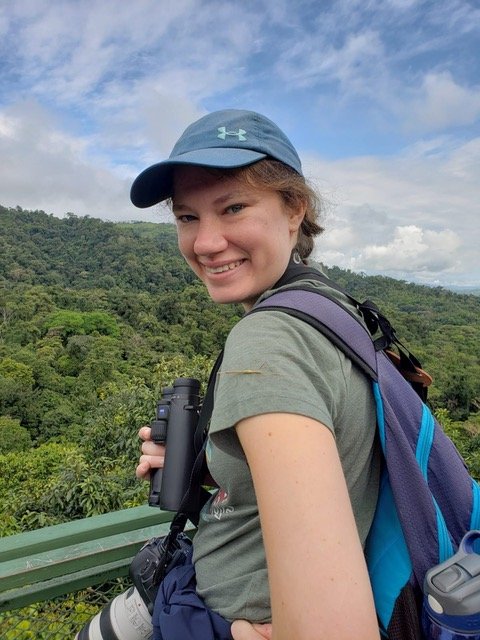People
Graduate Students
Brittany Cornell
Brittany is a fourth-year Biology PhD candidate interested in herpetology, evolutionary ecology and animal behavior. She studied biology during her undergrad at Sam Houston State University. She stayed at SHSU to complete her master’s in Biology, during which she worked on Agkistrodon piscivorus habitat and refuge selection, as well as skeletal morphology in Gekkota. In the Fitzpatrick lab, she studies reproductive ornamentation in female Phrynosomatid lizards.
Austen Ehrie
Austen is a fourth-year Biology PhD candidate who primarily studies animal behavior and organismal biology with an emphasis on sexual selection, mating behavior, and reproduction in non-human primates. Austen is particularly interested in exploring phenotypes that challenge traditional evolutionary paradigms. In 2022 he graduated from Indiana University with a BS in Animal Behavior and a BA in Environmental and Sustainability Studies. While at Indiana University Austen conducted two independent research projects: one investigating the neurotranscriptomic profiles of reproductive behaviors in a sex-role reversed shorebird (Jacana spinosa) and the other testing whether parallel laser photogrammetry could be used to measure the testes of mantled howler monkeys (Alouatta palliata) non-invasively. In the Fitzpatrick lab, he is examining how copulation rate and fetal/infant death influences the probability of conception in the female Amboseli baboons. Austen also enjoys watching horror movies and thinking of ideas for future tattoos.
Ruby Mustill
Ruby is a third-year Ecology and Evolutionary Biology (EEB) PhD student interested in life history, sexual selection, and the evolution of primate behavior and signaling. She studied anthropology and evolutionary biology at Columbia University, where she wrote a senior thesis comparing sexual swellings and sexual behavior in adolescent and adult female Kinda baboons. After graduating from Columbia in 2021, she studied rhesus macaques in Puerto Rico and Kinda baboons in Zambia. Ruby’s PhD research is focused on the evolution of adolescence in primates. She particularly enjoys reading about new findings that challenge traditional Darwinian ideas about sex roles in animals, and she aims to do the same with her future research.
Lab Mascot
Tallulah
Tallulah is the official mascot of the Fitzpatrick Lab. She is primarily interested in crickets.
Lab Alumni
Colton Watts
Colton's research focuses broadly on the evolutionary ecology of behavior and life history decisions, with an emphasis on combining empirical methods and mathematical modeling to bridge the gap between case studies and generalizable biological principles. His work spans a variety of specific topics ranging from daily rhythms and life history strategies to mate choice and sexual signaling. Colton is particularly interested in how selection on mate choice and sexual signaling behaviors changes with the social environment, and how these dynamics influence the relationships between evolutionary and ecological dynamics. As a postdoc in the Fitzpatrick Lab from 2021 to 2025, Colton used population genetic models to understand the evolution of female sexual signals in polygynous mating systems.
Paola Fascinetto Zago
Paola graduated from Texas A&M with a PhD in Ecology and Evolutionary Biology (EEB) in 2024. She was formally co-advised by Alan Pepper and Gil Rosenthal, but her interests in animal behavior and evolutionary ecology led her to become part of the Fitzpatrick Lab community. During her PhD, she studied the relationship between animal personality, learning, and mate choice in two species of Xiphophorus fish.
Elizabeth George
Elizabeth is broadly interested in the causes and consequences of social behavior, especially among reproductive females. She completed her dissertation in the lab of Dr. Kimberly Rosvall at Indiana University. There, she investigated behavioral and physiological responses to female-female competition in tree swallows, with an emphasis on aggressive behavior and the steroid hormone testosterone. As a postdoc in the Fitzpatrick Lab, Elizabeth used data collected from the long-running Amboseli Baboon Research Project to explore factors affecting fecundability, or the ability to conceive, in female baboons. She then tested several hypotheses that may explain the maintenance of variation in fecundability, and whether it relates to other aspects of their lives, such as female social interactions with males.
Cecile Renfro
Cecile’s research interests include comparative biology and community ecology. She completed her undergraduate degree in Plant Biology with a focus in Ecology and Management of Grassland Systems at the University of Nebraska-Lincoln. As a research assistant in the Fitzpatrick Lab, she cultivated a new appreciation for evolutionary biology while launching the lizard family Phrynosomatidae as a study system to understand the evolution of female ornamentation. Cecile recently completed a master’s degree in Ecology and Conservation Biology at Texas A&M under Dr. Daniel Spalink.
Juan Pablo Ríos
Juan Pablo’s research interests are primarily focused on animal behavior and sexual selection. He is particularly interested in how sexual signals have been shaped by mate choice. He recently achieved his undergraduate degree at Pontificia Universidad Javeriana in Bogotá, Colombia. As an undergraduate researcher in the Fitzpatrick Lab, Juan Pablo studied the evolution of reproductive coloration in female phrynosomatid lizards.








